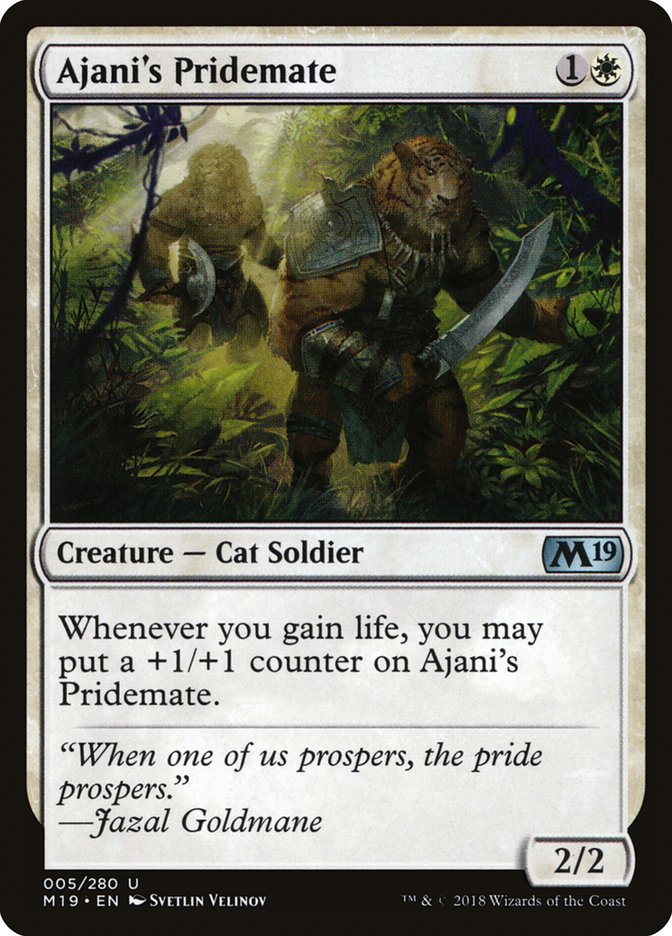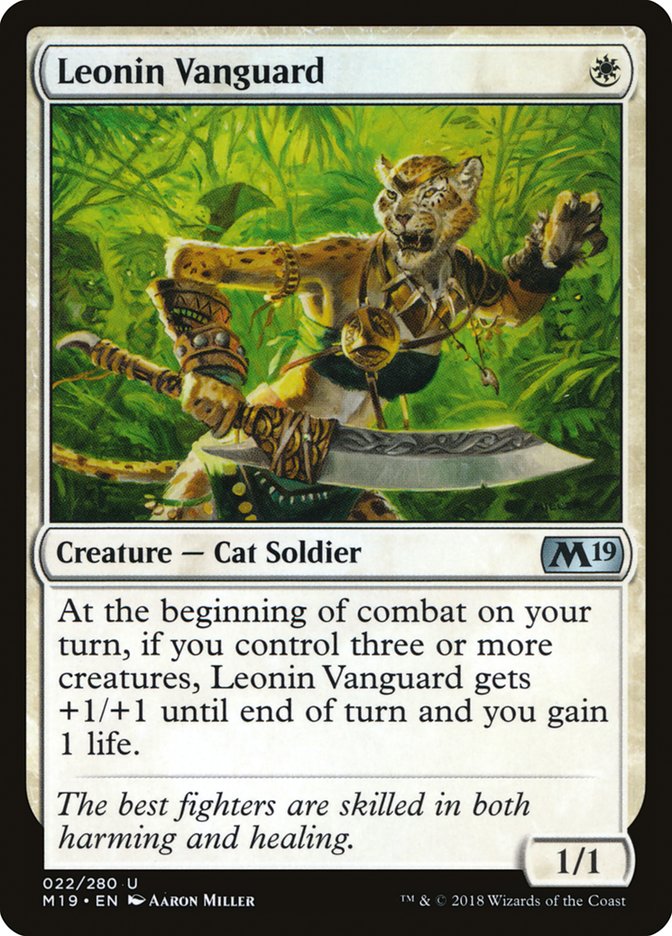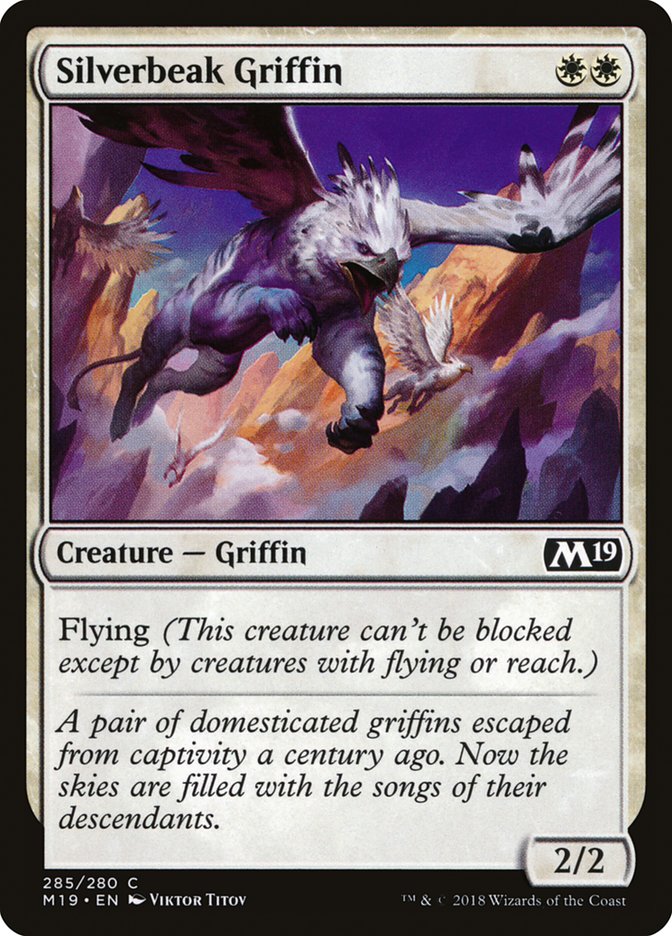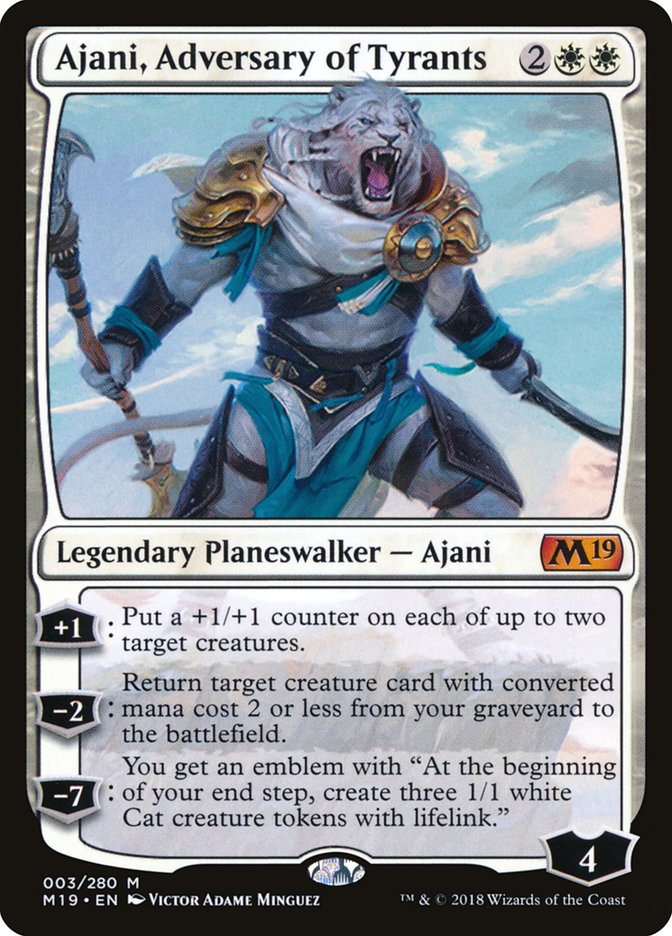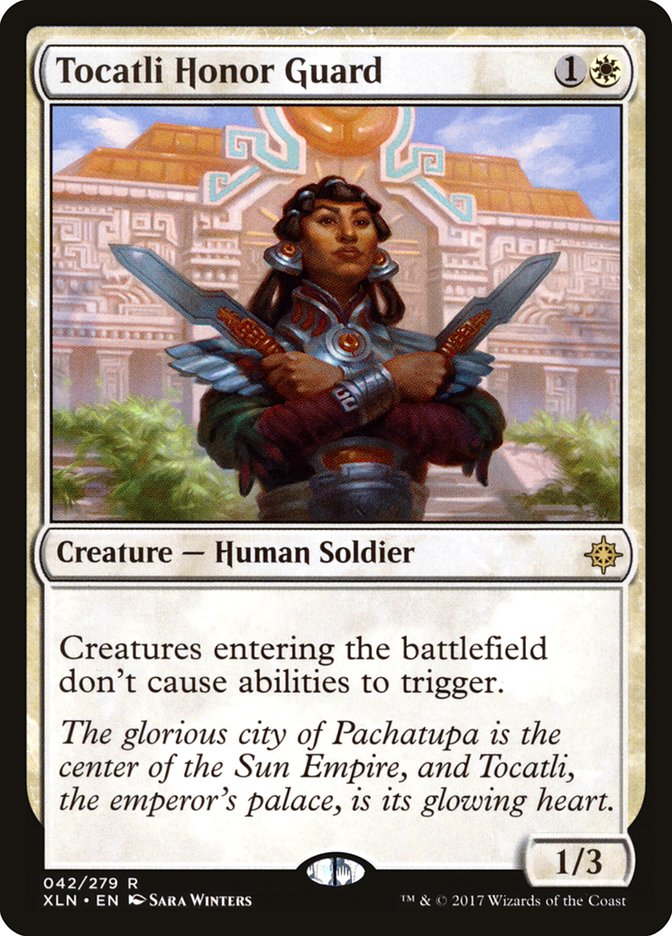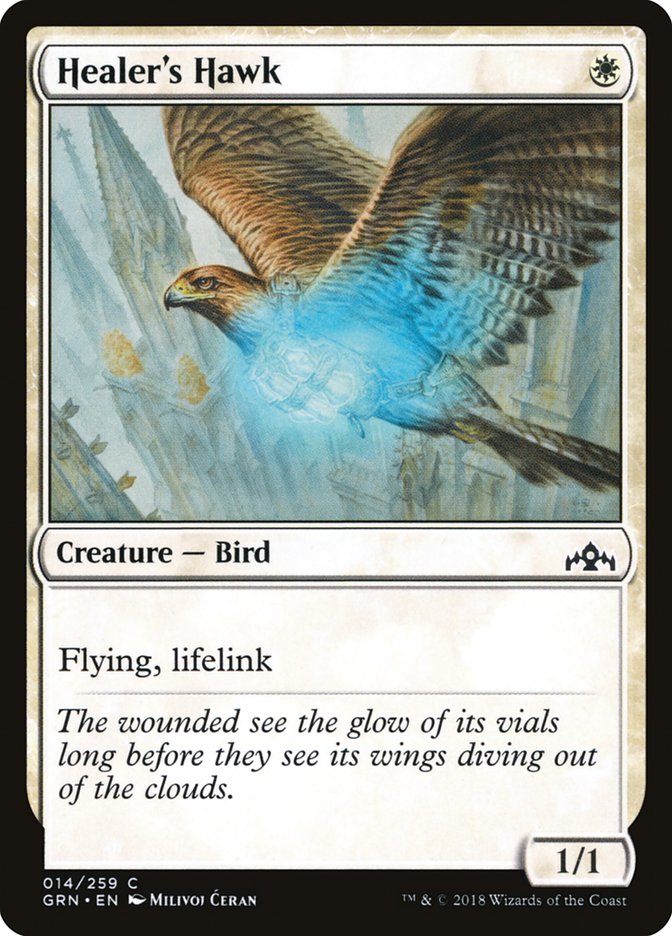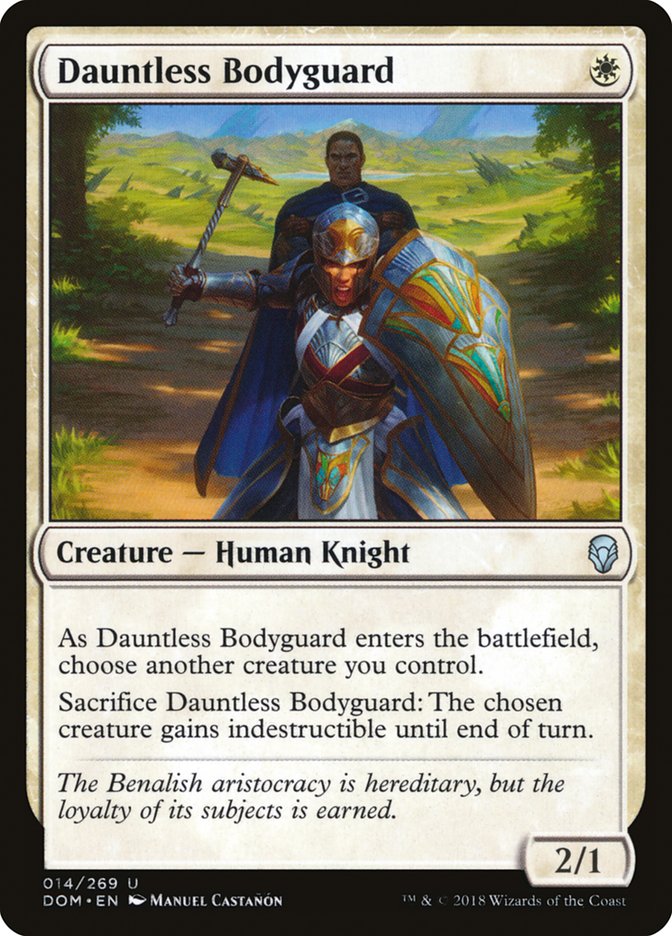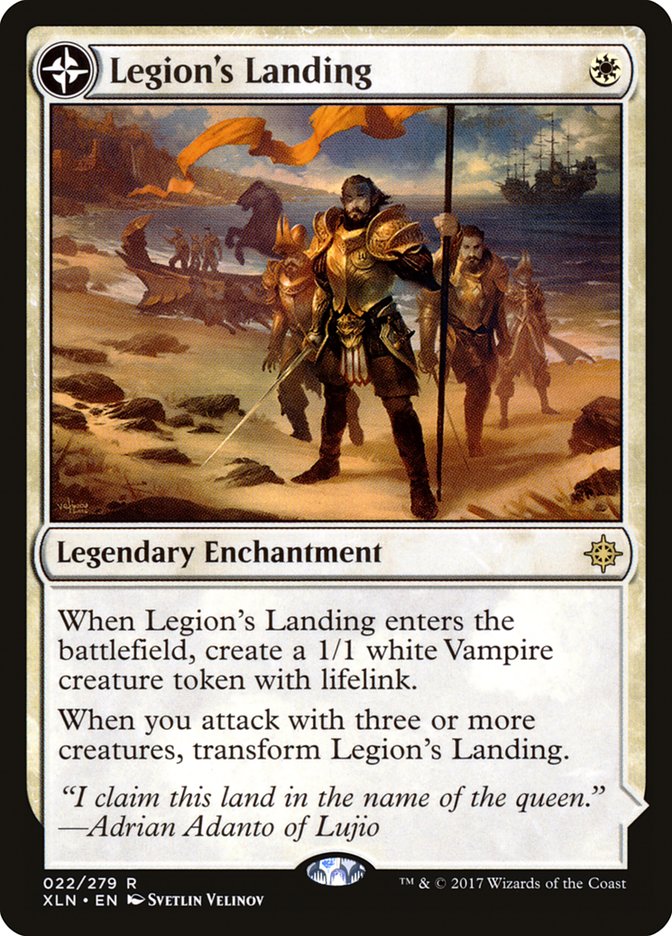For Pro Tour
Guilds of Ravnica,
I worked with a large group similar to the group I’d been working with
for previous Pro Tours that involved everyone on Team Channel Fireball,
Team UltraPro, and many others. Most of us elected to play our take on
white aggro, which was unique in that it played Ajani’s Pridemate and
Leonin Vanguard, and skipped Venerated Loxodon.
Leading up to the PT, we just couldn’t understand how no one else was
playing Ajani’s Pridemate. It’s easy to play twelve good one-mana creatures
that let you gain life, so it’s very easy to get Ajani’s Pridemate up to
3/3 or 4/4 before you even pass the turn, and it quickly becomes the
largest creature on the battlefield. It was baffling to us that people
would choose to play a 2/2 flier or Knight of Grace over this. We just
assumed everyone must have somehow missed it as an option, but even that
seemed impossible given that it’s a reprint that’s found success in Modern,
and Silverbeak Griffin is a card from the intro decks that most players
didn’t know existed.
CEDitor’s Note: I just learned that this is a card right now…
We tested Ajani’s Pridemate, and we were very happy with the results. It
was especially great for getting out ahead of Deafening Clarion such that
it would be too large for the sweeper to kill, and it was dominating the
battlefield against opposing white decks. We felt that Ajani’s Pridemate
meant our maindeck was better than other white decks, and we were very
happy with Experimental Frenzy as a sideboard card against people that
would make their deck more reactive and bring in more removal and sweepers,
which we thought would give us a great chance after sideboarding as well.
We thought those two cards were the primary draws to the deck beyond the
cards everyone already knew were great that the deck was built to take
advantage of like Adanto Vanguard and History of Benalia.
Creatures (27)
- 4 Ajani's Pridemate
- 4 Adanto Vanguard
- 3 Skymarcher Aspirant
- 4 Benalish Marshal
- 4 Dauntless Bodyguard
- 4 Leonin Vanguard
- 4 Healer's Hawk
Lands (20)
Spells (13)

The rest of us played similar decks, except that he was the only one to
play Settle the Wreckage in the sideboard. We discussed it as a sideboard
option at the last minute, and we weren’t sure how effective it would be.
People can play around it, but when we thought about people playing around
it, we decided it would be best if someone had it so that all our opponents
might be more likely to play around it. We discussed rolling for who had to
put it in their sideboard and talked about how they’d have to be loud and
tell stories about getting their opponent with it. Before it came to that
point, Luis volunteered to play one.
My deck differed a little further. I trusted Matt Severa, who had been
testing the deck on his own on Magic Online, and really liked Ajani,
Adversary of Tyrants, particularly in conjunction with Tocatli Honor Guard
against Golgari, so I made room for a few of each of those.
It’s normal to call a deck like this easy to play because you always know
your role and all your cards are very similar, but there are a lot of
decisions with this deck. Some are pretty counterintuitive.
The first question you run into in almost every game (well, after you’ve
kept your hand, which I’ll get to later) is which one-mana creature to lead
with. With nineteen cards that cost one mana, it’s very likely you’ll have
multiple options on the first turn. Usually, this means deciding whether to
prioritize the extra power of Skymarcher Aspirant or the evasion and
lifelink of Healer’s Hawk, but there isn’t a simple chain of always A, then
B, then C, etc.
If I’m on the play and I don’t know what my opponent’s playing, I’d ideally
play Leonin Vanguard first if I have two more one-mana creatures that I
want to play the following turn, as that offers the biggest life swing. If
I’m planning to cast Ajani’s Pridemate, I’d want to lead with Healer’s
Hawk, but if I don’t have one, I’d lead with Legion’s Landing over any of
the others, as I’ll probably be able to attack with the 1/1 on turn 2 on
the play and grow my Pridemate.
If I have Adanto Vanguard, I’d probably want to lead with a two-power
creature to maximize pressure, but I also don’t want to throw away
Dauntless Bodyguard’s ability if I don’t have to, so I’d probably play
Healer’s Hawk over Dauntless Bodyguard; however, I might play Dauntless
Bodyguard over Leonin Vanguard or Legion’s Landing since I don’t want to
give up power and evasion, and the fact that I have Adanto Vanguard as my
two-drop means that I won’t prioritize the Bodyguard as much because the
Adanto Vanguard can already become indestructible.
All of this can change based on the texture of your hand or what you know
about your opponent’s deck, especially if you’re on the draw.
The weirdest case that came up in testing was against Jeskai Control, where
it was sometimes right not to attack on turn 2. If you lead with a one-mana
creature and then play another one-mana creature and a Legion’s Landing, if
you attack, they can cast Seal Away on their turn to prevent you from
transforming Legion’s Landing, but if you don’t attack, you’re much more
likely to be able to transform Legion’s Landing, which matters a lot more
than one or two damage.
A similar consideration came up with Dauntless Bodyguard. Sometimes you’d
want to protect a worse creature that was untapped over a tapped creature
so that they couldn’t break your protection with Seal Away and then sweep
your creatures with Deafening Clarion.
Another important thing to consider is when you might want to decline a
trade where your creature would be trading up. For example, a Dauntless
Bodyguard that wasn’t protecting anything with a 3/2 Merfolk Branchwalker
out of consideration for the city’s blessing or having enough creatures to
transform Legion’s Landing.
Addressing the issue of which hands to keep, I think you almost never want
to keep a one-land, seven-card hand on the play. Yes, you’ll usually be
able to play something every turn until you draw a second land with these
hands, but so much of the strength of the deck is in ending the game
quickly, not in having the last threat after things trade, and you’ll
present a slower clock with any one-land hand than you would with almost
any hand where you play a second land on turn 2. It’s just too unlikely
that you’ll play your second land on turn 2 or even 3 with these hands.
On the draw, if your hand is great, especially if it contains Legion’s
Landing, it’s not terrible to keep, but I’m not sure you wouldn’t win more
if you threw all of those back too. Unfortunately, on six cards, play or
draw, I think you have to keep one-land hands with three one-mana cards and
probably with two and a two-mana card.
As for the other end of the spectrum, you should definitely never keep a
five-land hand with any two spells, and a four-land hand has to be
absolutely perfect, meaning one-drop, two-drop, and History of Benalia to
consider keep in it.
As for sideboarding, here’s what I’d do:
VS Boros Aggro
Out:

In:

Baffling End is more efficient than Conclave Tribunal and you don’t need a
lot of removal, you just want to be able to answer Benalish Marshal.
Aurelia dominates the battlefield, and Adanto Vanguard just costs too much
life to justify.
VS Jeskai Control
Out:

In:

On the play, it might be correct to leave Healer’s Hawk in and cut
Skymarcher Aspirant instead to maximize the chance that you can curve
Healer’s Hawk into Ajani’s Pridemate and get a 4/4 Pridemate on turn 3 to
dodge Deafening Clarion.
Benalish Marshal is an expensive spell that they can counter that just gets
swept up by Deafening Clarion, and it’s too hard to stick enough threats
for Pride of Conquerors (plus it’s awful against Settle the Wreckage). Your
plan is just to try to tap them out to stick an Experimental Frenzy, then
hope they can’t answer it.
In game 1, it’s important to understand that they’re often bad at
pressuring you, so you can be pretty conservative with your threats in
terms of playing around sweepers. After sideboaridng, you might need to
take more risks to end the game before they stick something like Lyra
Dawnbringer.
VS Izzet Drakes
Out:

In:

Because Izzet doesn’t have good answers to Adanto Vanguard, they’re
generally leaning heavily on being able to block with their Drakes.
Therefore, removal is great, and it might even be worth bringing in a
Baffling End or two if you suspect they have a lot of Enigma Drakes. Pride
of the Conquerors gets cut as usual because they’ll be killing too many of
your creatures
VS Mono-Red Aggro
Out:

In:

This matchup is very bad. You’d kind of like more Conclave Tribunals, but
you must watch your casting costs because it’s easy to have too many
expensive spells that you can’t cast because you can’t transform Legion’s
Landing.
VS Golgari Midrange
Out:

In:

The most important card in the matchup is Wildgrowth Walker, so you want
Baffling End to answer it, but you don’t want Conclave Tribunal because
it’s too devastating if they destroy it with a planeswalker. They have ways
to answer Experimental Frenzy as well, but sticking it is your easiest way
to win.
VS Boros Angels
Out:

In:

This is another awful matchup, and I’m not sure that this is the right
plan. You basically have to hope that they’re on a creature removal-heavy
draw that can’t answer Experimental Frenzy, or a threat-light draw and you
have Conclave Tribunal. In general, their Angels will just trump your
creatures.
VS Mono-Blue Tempo
Out:

In:

You’re just trying to race them. You want answers because their few
important cards – Tempest Djinn and Curious Obsession – matter so much more
than everything else, but they need to be cheap so you don’t get ruined by
their Spell Pierce or Dive Down.
Moving forward with the deck, I like Ajani’s Pridemate, but I don’t like
only playing twenty lands. It means you have to mulligan more, you don’t
curve out as smoothly, and it’s harder to sideboard into the high impact
for mana spells you want. Pride of Conquerors is the best card in the
mirror in game 1, but it’s too situational outside of that.
I’d look to cut Pride of Conquerors and some number of Skymarcher Aspirants
for more lands and 2-4 copies of Heroic Reinforcements. If you have
additional lands, I’m not sure that you need to change the sideboard much.
Maybe the sideboard Conclave Tribunals should be Ixalan’s Bindings at that
point.
If you’re looking to beat this deck, there are three decks I’d recommend:
Boros Angels
Cheap red removal with access to Deafening Clarion and/or Settle the
Wreckage and then a bunch of Angels that dominate the battlefield is a
nightmare for Boros Aggro. They just don’t have enough removal to keep the
Angels in check, and the Angels close the game too fast for Experimental
Frenzy to bail the aggro deck out.
Mono-Red Aggro
Goblin Chainwhirler is still great against a deck full of one toughness
creatures, Runaway Steam-Kin is great against a deck with very little
removal, and if you really want to lock up the matchup, Siege-Gang
Commander takes over the game instantly.
Golgari Midrange
You must be careful here. You can’t play just any Golgari Midrange deck.
I’d recommend the deck Matt Nass went 8-2 with:
Creatures (24)
- 4 Llanowar Elves
- 1 Carnage Tyrant
- 4 Wildgrowth Walker
- 4 Merfolk Branchwalker
- 2 Seekers' Squire
- 4 Jadelight Ranger
- 2 Ravenous Chupacabra
- 3 Doom Whisperer
Planeswalkers (2)
Lands (24)
Spells (10)
Sideboard

Wildgrowth Walker, Cast Down, and Doom Whisperer give Matt’s deck a unique
edge against aggressive white decks. Wildgrowth Walker is the easiest way
to run away with a game and prevent them from doing the same, Cast Down is
a cheap instant-speed answer (which is extremely important against Benalish
Marshal), and Doom Whisperer blocks fliers and ends the game before they
can take over with Experimental Frenzy.
While this deck is powerful and an important piece of the metagame to
understand, I think there are enough strategies that can create heavily
favorable matchups if they’re trying to beat this deck that playing it
right after this Pro Tour performance would be a mistake. Now is a great
time to understand Boros Aggro and prepare to beat it.


